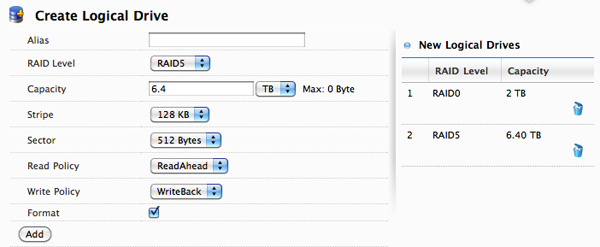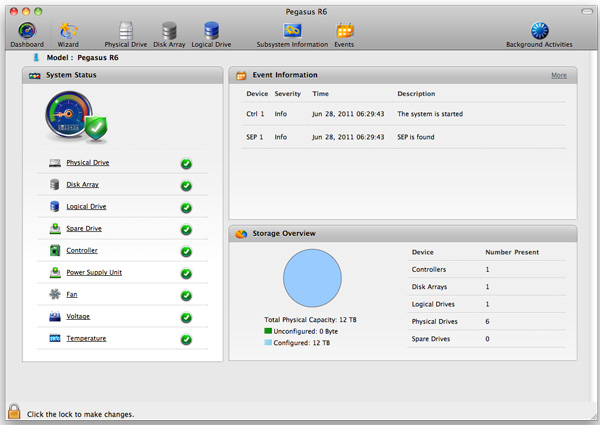Promise Pegasus R6 & Mac Thunderbolt Review
by Anand Lal Shimpi on July 8, 2011 2:01 AM ESTThe Pegasus: Software
The Pegasus ships fully functional from the factory, but you'll need to do a couple of things to your Mac before the first Thunderbolt device on the market will just work. First, the Pegasus (or any TB device) will only work on a 2011 MacBook Pro or 2011 iMac as those are the only two systems on the market today with an integrated Thunderbolt controller. Apple is widely expected to introduce a new Mac Pro and maybe even a new MacBook Air with Thunderbolt support, but for now you need a 2011 MBP or iMac.
![]()
If you have one of those two systems you'll need two software updates. The first is the Mac Thunderbolt Firmware Update and the second is Mac OS X 10.6.8 (or later, Lion is supported). With both software updates installed, simply plug in a Thunderbolt cable and you'll be greeted with a Promise RAID icon on your desktop.
The bundled Promise Utility gives you full control over the Pegasus including reporting on drive/array health:
The major functions of the Promise Utility are pretty self explanatory. The Dashboard is the home screen of the application, it gives you a quick look at the current status of your drives/arrays (e.g. green for good, yellow for caution, red for major issue):
By default the Pegasus ships in a RAID-5 configuration with either 4 or 6 drives depending on whether you bought an R4 or R6 model. The RAID-5 array is configured with a 128KB stripe size and 512-byte sector size. This generally offers the best balance of redundancy and performance for most users, however if you'd like to delete it and start anew you can.
The wizard gives you one click array creation if you don't want to deal with adjusting things like stripe and sector sizes. There are varying levels of advanced array creation, or you can always go full manual.

You can choose any combination of drives in the Pegasus to be included in a disk array. From there you can partition the aforementioned disk array into any valid RAID array(s) you'd like. For example, you can choose to include all 6 drives in an array and from there create a 2TB RAID-0 and use the remaining space as a 6.4TB RAID-5. Alternatively, you can use five drives in an array and use one as a hot spare. Finally you can choose to only use some of the drives in an array and leave the remaining drives in pass-through mode, accessible outside of any RAID arrays.
Any drives you don't include in the drive array can be set as spares.
The table below shows you the options you have when creating a custom drive array on the Pegasus (I've highlighted the defaults):
| Promise Pegasus Array Creation Options | ||||
| Item | Options | |||
| RAID Level | RAID0, RAID1E, RAID5, RAID6, RAID10, RAID50 | |||
| Stripe | 64KB, 128KB, 256KB, 512KB, 1MB | |||
| Sector | 512 Bytes, 1KB, 2KB, 4KB | |||
| Read Policy | ReadCache, ReadAhead, No Cache | |||
| Write Policy | WriteThru, WriteBack | |||
All major configuration changes require that you type the word "confirm" before proceeding, a nice way to ensure you don't accidentally delete something.

The Promise Utility reports on both array and drive level events. It'll tell you basic things like whether or not your current array is healthy or down a drive. At the drive level you do get basic SMART reporting including temperature and health status. You also have the option of dumping an advanced SMART log to a text file which includes the drive vendor specific SMART attributes and their current, worst and threshold values:

In the utility's physical drive list you can locate any drive in the Pegasus array. Hitting the locate button will cause the corresponding identify LED to blink on the Pegasus.
Like any other array under OS X, you do have to manually eject any volumes before unplugging the Thunderbolt cable or powering down the Pegasus. Failing to do so will give you this all-too-familiar error:



















88 Comments
View All Comments
darwinosx - Friday, July 8, 2011 - link
Hardly anyone uses projectors so VGA ports should only be on business class laptops.Zok - Friday, July 8, 2011 - link
Can't say I agree with you there. Despite being issued a corporate laptop, I use my personal one for most of my work, including (VGA-requisite) projector presenting.cacca - Friday, July 8, 2011 - link
some questions:Does USB 3 port do the same?
Does the PCI-E external do the same?
Does External SATA do the same?
Thunderbolt is just another PROPRIETARY standard that competes with others.
It reminds me RAMBUS.
were cost and compatibility matters. Is faster but....
We will ever seen a review of something from Intel that points out the shortcomings?
or this place is ADDtech instead of anandtech?
André - Friday, July 8, 2011 - link
Rest assured that USB 3.0 does NOT in any way or form do the same as Thunderbolt.The protocols are very different, as in, USB 3.0 nearly doesn't support any and Thunderbolt being an extension of a 4 x PCI-Express slot does support heaps of features, like Target Disk Mode, S.M.A.R.T.-status, Native Command Queuing, daisy-chaining (with very low latency) making it ideal for many professional applications (Audio/Visual devices), bi-directional bandwidth, DisplayPort, 10 Watt of power and native software driver support.
Just to name a few.
External SATA doesn't do the same either.
Thunderbolt is a multi-purpose connector, not limited to only storage or transfer of files.
If you for a minute think that USB or E-SATA does the same as Thunderbolt, then you need to educate yourself.
It has the potential to replace all other external connectors. One cable to rule them all, instead of legacy cables that clutter up the backside of your computer and collect dust.
Anato - Friday, July 8, 2011 - link
And one controller (maker) to rule us all. Thats a big problem in PC, but not necessarily in Mac.Jaybus - Sunday, July 10, 2011 - link
Not really. Light Peak is essentially protocol agnostic. It tunnels PCI-E. The PCI-E-to-whatever bridge is built into the cable and/or dongle. In other words, a USB 3.0 adapter/hub that plugs into a Light Peak port is possible and even likely.While Intel may control the Light Peak controller, which will no doubt be integrated into motherboard chipsets, I don't think that will give them a monopoly on the bridge chips that make LP actually useful.Exodite - Friday, July 8, 2011 - link
Cue 'potential'.It's not hard to foresee another Firewire or mini-DP in the making, or a Beta if you prefer going old-school.
Coupling Light Peak technology with mini-DP was a mistake. The technology is new, unproven and offers precious few usage scenarios with non-existent device support. Piggy-backing it on mini-DP, which suffer from pretty much exactly the same issues, won't help adoption rates.
Choosing USB over mini-DP as the 'legacy' interface would have been a much better choice.
André - Friday, July 8, 2011 - link
Except that the USB connector is only allowed to be used as an USB connector.DisplayPort is also vastly superior to any other display cable standard, so I cannot see the problem in that regard. Mini-Display is already shipping in millions and millions of computers, as well as Mini-DisplayPort. The same can be said by Thunderbolt, even though it is only Apple who have fully embraced the technology.
As a professional in the audio/visual segment I can hardly see the problem with it being a repeat of FireWire, because my market usually adopts the better technology despite of a small price increase. Of course, it helps that we only use Apple computers to begin with and have already ditched all the back-alley, legacy connectors.
Uritziel - Friday, July 8, 2011 - link
Heh, yet another continuation of the myth that media professionals only use macs...André - Friday, July 8, 2011 - link
Kindly don't put words in my mouth ;)I didn't say media professionals only use Apple computers, I said my company only use them.
As for now it only makes sense to discuss Thunderbolt and Apple computers as Apple are the only ones who has it currently.
But you just have to look at the companies that are releasing Thunderbolt enabled devices to understand that this connector is really something professionals are going to use. Next year the market will open up when PC vendors finally, if they so choose, to embrace the technology.